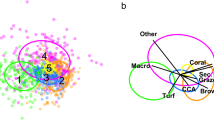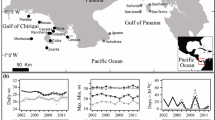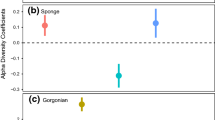Abstract
The Arabian Gulf is a natural laboratory to examine how subtropical coral reef ecosystems might change in responding to recurring heating events because of uniquely high water temperature and relatively low fish diversity. Several statistical methods were applied to long-term (30 yrs) monitoring data in the western Arabian Gulf to extract clean signals of the fish abundances, to reveal common trends in the multivariate time series, and to test for nonlinear and lagged effects of coral coverage and sea surface temperature as predictors. Data were analyzed at three taxonomic resolutions: species (29 species out of a total of 148 species, contributing to 69% of total observations), genus (24 genera, 81%), and family (19 families, 96%), to test the taxonomic sufficiency hypothesis, which asserts that there is no significant loss of information at higher taxonomic levels for detecting changes in the fish assemblages. Multivariate abundance time series can be summarized by dynamic factor models of four common trends, which were supported by time series clustering and good model fitting performances. The taxonomic sufficiency hypothesis is supported for the first two common trends, which showed similarity among the three taxonomic resolutions. The effects of changes in coral coverage on the fish community are nonlinear and significantly lagged with lags mostly of 8 yrs, while the effects of mean sea surface temperature were significant but inconclusive. The fish communities in the coral reefs of the western Arabian Gulf are degrading in general with decreasing abundance at the three taxonomic resolutions. Analyzing data at coarser taxonomic resolutions can be informative in revealing the general trends of the abundance of coral reef fish communities, at the cost of ignoring variations at finer resolutions. This study further highlights the importance of long-term and continuous monitoring of the coral reef ecosystem at the finest possible taxonomic level to fully reveal slow but crucial changes in fish communities, as well as to detect signs of communities’ degradation to take timely restoration actions.







Similar content being viewed by others
References
Achituv Y, Dubinsky Z (1990) Evolution and zoogeography of coral reefs. In: Dubinsky Z (ed) Ecosystems of the World, 25. Coral Reefs, Elsevier, Amsterdam, The Netherlands, pp 1–9
Aghabozorgi S, Shirkhorshidi AS, Wah TY (2015) Time-series clustering-a decade review. Inf Sys 53:16–38
Allen GR, White WT, Erdmann MV (2013a) Two new species of snappers (Pisces: Lutjanidae: Lutjanus) from the Indo-West Pacific. J Ocean Sci Found 6:33–51
Allen GR, Erdmann MV, Randall JE, Ching P, Rauzon MJ, Hayashi LA, Thomas MD, Robertson DR, Taylor L, Coste M (2013b) Reef fishes of the East Indies. Conservation International Foundation, Indonesia.
Alosairi Y, Alsulaiman N, Rashed A, Al-Houti D (2020) World record extreme sea surface temperatures in the northwestern Arabian/Persian Gulf verified by in situ measurements. Mar Poll Bull 161:111766
Azevedo M, Duarte R, Cardador F, Sousa P, Farina C, Sampedro P, Landa J, Costas G (2008) Application of dynamic factor analysis in the assessment of Iberian anglerfish stocks. ICES J Mar Sci 65:1362–1369
Banzon V, Smith TM, Chin TM, Liu CY, Hankins W (2016) A long-term record of blended satellite and in situ sea-surface temperature for climate monitoring, modeling and environmental studies. Earth Syst Sci Data 8:165–176
Bell JD, Galzin R (1984) Influence of live coral cover on coral-reef fish communities. Mar Ecol Prog Ser 15:265–274
Bogorodsky SV, Randall JE (2019) Endemic fishes of the Red Sea. In: Rasul NMA, Stewart ICF (eds) Oceanographic and biological aspects of the Red Sea. Springer, Cham, Switzerland, pp 239–265
Brandl SJ, Johansen JL, Casey JM, Tornabene L, Morais RA, Burt JA (2020) Extreme environmental conditions reduce coral reef fish biodiversity and productivity. Nat Commun 11:1–14
Brokovich E, Baranes A, Goren M (2006) Habitat structure determines coral reef fish assemblages at the northern tip of the Red Sea. Ecol Indic 6:494–507
Buchanan JR, Krupp F, Burt JA, Feary DA, Ralph GM, Carpenter KE (2016) Living on the edge: Vulnerability of coral-dependent fishes in the Gulf. Mar Pollut Bull 105:480–488
Buchanan JR, Ralph GM, Krupp F, Harwell H, Abdallah M, Abdulqader E, Al-Husaini M, Bishop JM, Burt JA, Choat JH, Collette BB, Feary DA, Hartmann SA, Iwatsuki Y, Kaymaram F, Larson HK, Matsuura K, Motomura H, Munroe T, Russell B, Smith-Vaniz W, Williams J, Carpenter KE (2019) Regional extinction risks for marine bony fishes occurring in the Persian/Arabian Gulf. Biol Conserv 230:10–19
Burnham KP, Anderson DR (2002) Model selection and multimodel inferences: a practical information-theoretic approach, 2nd edn. Springer, New York, USA
Burt JA, Feary DA, Bauman A, Usseglio P, Cavalcante G, Sale P (2011) Biogeographic patterns of reef fish community structure in the northeastern Arabian Peninsula. ICES J Mar Sci 68:1875–1883
Burt JA, Paparella F, Al-Mansoori N, Al-Mansoori A, Al-Jailani H (2019) Causes and consequences of the 2017 coral bleaching event in the southern Persian/Arabian Gulf. Coral Reefs 38:567–589
Burt JA, Camp E, Enochs IC, Johansen JL, Morgan KM, Riegl B, Hoey AS (2020) Insights from extreme coral reefs in a changing world. Coral Reefs 39:495–507
Cant J, Salguero-Gómez R, Kim SW, Sims CA, Sommer B, Brooks M, Malcolm HA, Pandolfi JM, Beger M (2021) The projected degradation of subtropical coral assemblages by recurrent thermal stress. J Anim Ecol 90:233–247
Ceccarelli DM, Emslie MJ, Richards ZT (2016) Post-disturbance stability of fish assemblages measured at coarse taxonomic resolution masks change at finer scales. PLoS ONE 11:e0156232
Coker DJ, Wilson SK, Pratchett MS (2014) Importance of live coral habitat for reef fishes. Rev Fish Biol Fisher 24:89–126
Coles SL, Fadlallah YH (1991) Reef coral survival and mortality at low temperatures in the Arabian Gulf: new species-specific lower temperature limits. Coral Reefs 9:231–237
Coles SL, Tarr BA (1990) Reef fish assemblages in the western Arabian Gulf: a geographically isolated population in an extreme environment. Bull Mar Sci 47:696–720
Cruz IC, Loiola M, Albuquerque T, Reis R, Jose de Anchieta CC, Reimer JD, Mizuyama M, Kikuchi RK, Creed JC (2015) Effect of phase shift from corals to Zoantharia on reef fish assemblages. PLoS ONE 10:e0116944
Cruz IC, Waters LG, Kikuchi RK, Leão ZM, Turra A (2018) Marginal coral reefs show high susceptibility to phase shift. Mar Poll Bull 135:551–561
D’Agostino D, Burt JA, Reader T, Vaughan GO, Chapman BB, Santinelli V, Cavalcante GH, Feary DA (2020) The influence of thermal extremes on coral reef fish behaviour in the Arabian/Persian Gulf. Coral Reefs 39:733–744
D’Agostino D, Burt JA, Santinelli V, Vaughan GO, Fowler AM, Reader T, Taylor BM, Hoey AS, Cavalcante GH, Bauman AG, Feary DA (2021) Growth impacts in a changing ocean: insights from two coral reef fishes in an extreme environment. Coral Reefs 40:433–446
D’Angelo C, Hume BC, Burt J, Smith EG, Achterberg EP, Wiedenmann J (2015) Local adaptation constrains the distribution potential of heat-tolerant Symbiodinium from the Persian/Arabian Gulf. ISME J 9:2551–2560
Demirhan H (2020) dLagM: An R package for distributed lag models and ARDL bounds testing. PLoS ONE 15:e0228812
Ellis D (1985) Taxonomic sufficiency in pollution assessment. Mar Poll Bull 16:459
Feary DA, Almany GR, McCormick MI, Jones GP (2007) Habitat choice, recruitment and the response of coral reef fishes to coral degradation. Oecologia 153:727–737
Floeter SR, Bender MG, Siqueira AC, Cowman PF (2018) Phylogenetic perspectives on reef fish functional traits. Biol Rev 93:131–151
Frédérich B, Sorenson L, Santini F, Slater GJ, Alfaro ME (2013) Iterative ecological radiation and convergence during the evolutionary history of damselfishes (Pomacentridae). Am Nat 181:94–113
Froese R, Pauly, D (2019) FishBase. World Wide Web electronic publication. www.fishbase.org (12/2019).
Goreau TJ, Hayes RL (1994) Coral bleaching and ocean “hot spots.” Ambio 23:176–180
Graham NA, Wilson SK, Jennings S, Polunin NV, Robinson JAN, Bijoux JP, Daw TM (2007) Lag effects in the impacts of mass coral bleaching on coral reef fish, fisheries, and ecosystems. Conserv Biol 21:1291–1300
Guitet S, Sabatier D, Brunaux O, Hérault B, Aubry-Kientz M, Molino JF, Baraloto C (2014) Estimating tropical tree diversity indices from forestry surveys: A method to integrate taxonomic uncertainty. For Ecol Manag 328:270–281
Hume BC, D’Angelo C, Smith EG, Stevens JR, Burt J, Wiedenmann J (2015) Symbiodinium thermophilum sp. nov., a thermotolerant symbiotic alga prevalent in corals of the world’s hottest sea, the Persian/Arabian Gulf. Sci Rep 5:1–8
Iwatsuki Y (2013) Review of the Acanthopagrus latus complex (Perciformes: Sparidae) with descriptions of three new species from the Indo-West Pacific Ocean. J Fish Biol 83:64–95
Jones GP, McCormick MI, Srinivasan M, Eagle JV (2004) Coral decline threatens fish biodiversity in marine reserves. Proc Natl Acad Sci 101:8251–8253
Jørgensen B (1997) The theory of dispersion models. Chapman & Hall, London, UK
Komyakova V, Munday PL, Jones GP (2013) Relative importance of coral cover, habitat complexity and diversity in determining the structure of reef fish communities. PLoS ONE 8:e83178
Krishnakumar PK, Lindo R (2019) Chapter 3.10: coral reef ecosystem the Hermatypic Scleractinian (hard) corals. In: Al-Abdulkader K, Loughland RA, Qurban MA (Eds.), Ecosystems and Biodiversity of the Arabian Gulf Saudi Arabian Waters: 50 Years of Marine Research. Saudi Aramco and King Fahd University of Petroleum and Minerals, 278–308.
Lin YJ, Qurban MA, Shen KN, Chao NL (2019a) Delimitation of Tigertooth Croaker Otolithes Species (Teleostei: Sciaenidae) from the Western Arabian Gulf Using an Integrative Approach, with a Description of Otolithes arabicus sp. Nov. Zool Stud 58:e10
Lin YJ, Grandcourt EM, Rabaoui L, Maneja RH, Qurban MA, Al-Abdulkader K, Roa-Ureta RH (2019b) Comparative analysis of life history traits and trends of abundance in coral reefs of the orange-spotted grouper (Epinephelus coioides) from two regions of the Arabian Gulf. ICES J Mar Sci 76:987–998
Lin YJ, Rabaoui L, Maneja RH, Qurban MA, Abdulkader K, Al-Nazry H, Roa-Ureta RH (2019c) Life history traits and temporal trends of abundance of the orange-spotted trevally (Carangoides bajad) from Saudi waters of the Gulf. J Fish Biol 95:1184–1194
Lin YJ, Rabaoui L, Basali AU, Lopez M, Lindo R, Krishnakumar PK, Qurban MA, Prihartato PK, Cortes DL, Qasem A, Al-Abdulkader K (2021) Long-term ecological changes in fishes and macro-invertebrates in the world’s warmest coral reefs. Sci Total Environ 750:142254
Litzow MA, Hunsicker ME, Ward EJ, Anderson SC, Gao J, Zador S, Batten S, Dressel S, Duffy-Anderson J, Fergusson E, Hopcroft R (2020) Evaluating ecosystem change as Gulf of Alaska temperature exceeds the limits of preindustrial variability. Prog Oceanogr 186:102393
Magel JM, Dimoff SA, Baum JK (2020) Direct and indirect effects of climate change-amplified pulse heat stress events on coral reef fish communities. Ecol Appl 30:e02124
Maunder MN, Punt AE (2004) Standardizing catch and effort data: a review of recent approaches. Fish Res 70:141–159
McLean M, Mouillot D, Lindegren M, Villéger S, Engelhard G, Murgier J, Auber A (2019) Fish communities diverge in species but converge in traits over three decades of warming. Glob Chang Biol 25:3972–3984
Michael SW (2009) Wrasses and Parrotfishes: The complete illustrated guide to their identification, behaviors, and captive care. TFH Publications, New Jersey, USA
Moraes LE, Paes E, Garcia A, Möller O Jr, Vieira J (2012) Delayed response of fish abundance to environmental changes: a novel multivariate time-lag approach. Mar Ecol Prog Ser 456:159–168
Murtagh F, Legendre P (2014) Ward’s hierarchical agglomerative clustering method: which algorithms implement Ward’s criterion? J Classif 31:274–295
NOAA (2020) National Centers for Environmental Information, State of the Climate: Global Climate Report for Annual 2020, online January 2021, retrieved on March 15, 2021 from https://www.ncdc.noaa.gov/sotc/global/202013.
Noori R, Tian F, Berndtsson R, Abbasi MR, Naseh MV, Modabberi A, Soltani A, Kløve B (2019) Recent and future trends in sea surface temperature across the Persian Gulf and Gulf of Oman. PLoS ONE 14:e0212790
Paparrizos J, Gravano L (2015) k-shape: Efficient and accurate clustering of time series. Proceedings of the 2015 ACM SIGMOD International Conference on Management of Data, 1855–1870.
Parravicini V, Kulbicki M, Bellwood DR, Friedlander AM, Arias-Gonzalez JE, Chabanet P, Floeter SR, Myers R, Vigliola L, D’Agata S, Mouillot D (2013) Global patterns and predictors of tropical reef fish species richness. Ecography 36:1254–1262
R Core Team (2020). R: A language and environment for statistical computing. R Foundation for Statistical Computing, Vienna, Austria. https://www.R-project.org/.
Rabaoui L, Yacoubi L, Sanna D, Casu M, Scarpa F, Lin YJ, Shen KN, Clardy TR, Arculeo M, Qurban MA (2019) DNA barcoding of marine fishes from Saudi Arabian waters of the Gulf. J Fish Biol 95:1286–1297
Randall JE, Allen GR, Steene RC (1998) Fishes of the great barrier reef and coral sea. University of Hawaii Press, Honolulu
Riegl B (2002) Effects of the 1996 and 1998 positive sea-surface temperature anomalies on corals, coral diseases and fish in the Arabian Gulf (Dubai, UAE). Mar Biol 140:29–40
Riegl BM, Purkis SJ (2012) Coral reefs of the Gulf: adaptation to climatic extremes in the world’s hottest sea. In: Riegl BM, Purkis SJ (eds) Coral reefs of the Gulf. Springer, Dordrecht, Netherland, pp 1–4
Riegl BM, Purkis SJ, Al-Cibahy AS, Abdel-Moati MA, Hoegh-Guldberg O (2011) Present limits to heat-adaptability in corals and population-level responses to climate extremes. PLoS ONE 6:e24802
Roberts CM, Ormond RF (1987) Habitat complexity and coral reef fish diversity and abundance on Red Sea fringing reefs. Mar Ecol Prog Ser 41:1–8
Russ GR, Rizzari JR, Abesamis RA, Alcala AC (2021) Coral cover a stronger driver of reef fish trophic biomass than fishing. Ecol App 31:e02224
Sale PF, Guy JA (1992) Persistence of community structure: what happens when you change taxonomic scale? Coral Reefs 11:147–154
Sarda-Espinosa A (2019) dtwclust: Time series clustering along with optimizations for the dynamic time warping distance. R package version 5.5.6. https://CRAN.R-project.org/package=dtwclust.
Shinn EA (1976) Coral reef recovery in Florida and the Persian Gulf. Environ Geol 1:241–254
Tascheri R, Saavedra-Nievas JC, Roa-Ureta R (2010) Statistical models to standardize catch rates in the multi-species trawl fishery for Patagonian grenadier (Macruronus magellanicus) off Southern Chile. Fish Res 105:200–214
Terlizi A, Anderson MJ, Bevilacqua S, Fraschetti S, Włodarska-Kowalczuk M, Ellingsen KE (2009) Beta diversity and taxonomic sufficiency: Do higher-level taxa reflect heterogeneity in species composition? Diversity Distrib 15:450–458
Thiault L, Bevilacqua S, Terlizzi A, Claudet J (2015) Taxonomic relatedness does not reflect coherent ecological response of fish to protection. Biol Conserv 190:98–106
Vaughan GO, Shiels HA, Burt JA (2021) Seasonal variation in reef fish assemblages in the environmentally extreme southern Persian/Arabian Gulf. Coral Reefs 40:405–416
Vehtari A, Gelman A, Gabry J (2017) Practical Bayesian model evaluation using leave-one-out cross-validation and WAIC. Stat Comp 27:1413–1432
Vehtari A, Gabry J, Magnusson M, Yao Y, Bürkner P, Paananen T, Gelman A (2020) loo: efficient leave-one-out cross-validation and WAIC for Bayesian models. R package version 2.3.1. https://mc-stan.org/loo.
Venables WN, Dichmont CM (2004) GLMs, GAMs and GLMMs: an overview of theory for applications in fisheries research. Fish Res 70:319–337
Ward EJ, Anderson SC, Damiano LA, Hunsicker ME, Litzow MA (2019) Modeling regimes with extremes: the bayesdfa package for identifying and forecasting common trends and anomalies in multivariate time-series data. R J 11:46–55
Wismer S, Tebbett SB, Streit RP, Bellwood DR (2019) Spatial mismatch in fish and coral loss following 2016 mass coral bleaching. Sci Total Environ 650:1487–1498
Wood SN (2017) Generalized additive models: An introduction with R, 2nd edn. Chapman and Hall/CRC, London, UK
Zhang Y (2013) Likelihood-based and bayesian methods for tweedie compound poisson linear mixed models. Stat Comp 23:743–757
Zimmermann F, Claireaux M, Enberg K (2019) Common trends in recruitment dynamics of north-east Atlantic fish stocks and their links to environment, ecology and management. Fish Fish 20:518–536
Zuur AF, Tuck ID, Bailey N (2003) Dynamic factor analysis to estimate common trends in fisheries time series. Can J Fish Aquat Sci 60:542–552
Acknowledgements
We are grateful for the Marine Studies Section, Center for Environment and Water, King Fahd University of Petroleum and Minerals, to provide logistic support. Saudi Aramco for financial support (Project ID: CEW02428).
Author information
Authors and Affiliations
Corresponding author
Ethics declarations
Conflict of interest
On behalf of all authors, the corresponding author states that there is no conflict of interest.
Additional information
Publisher's Note
Springer Nature remains neutral with regard to jurisdictional claims in published maps and institutional affiliations.
Topic Editor Morgan S. Pratchett
Supplementary Information
Below is the link to the electronic supplementary material.
Rights and permissions
About this article
Cite this article
Lin, YJ., Roa-Ureta, R.H., Basali, A.U. et al. Coarser taxonomic resolutions are informative in revealing fish community abundance trends for the world’s warmest coral reefs. Coral Reefs 40, 1741–1756 (2021). https://doi.org/10.1007/s00338-021-02181-z
Received:
Accepted:
Published:
Issue Date:
DOI: https://doi.org/10.1007/s00338-021-02181-z




